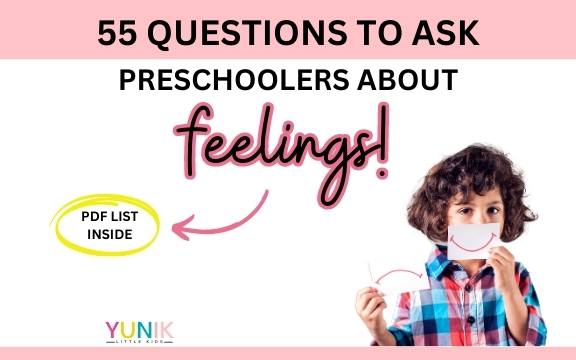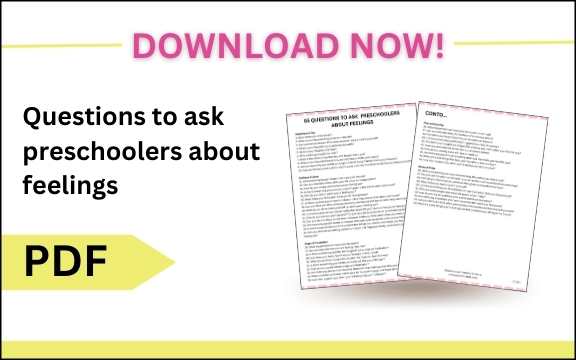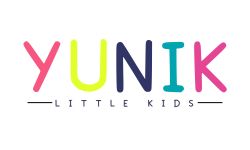
55 Questions to ask preschoolers about feelings
Got a preschooler at home? These 55 questions to ask about feelings can be a great way to start conversation with your child everyday!
As parents, guardians, or educators, we understand the profound impact that emotions have on a child’s overall well-being.
Children, even at a young age, experience a wide range of emotions that shape their understanding of the world and their interactions with others. It is crucial for us to foster a safe and nurturing environment where they can express their feelings openly.
That’s why I am excited to share this blog post with you, which aims to provide a valuable resource for understanding and addressing your preschooler’s emotions.
In this blog post, we will explore a carefully curated list of questions designed specifically to engage preschoolers in conversations about their feelings.

After a busy school day or a tired play date, by asking these questions, you can gain insight into their emotional experiences, help them develop emotional literacy, and strengthen your bond with them.
These questions cover a range of emotions and are categorized to make it easier for you to navigate discussions with your little ones.
But that’s not all! As a bonus, I am offering a free printable questions list that you can download and use as a handy reference whenever you want to connect with your preschooler on a deeper emotional level.
This printable will serve as a valuable tool in nurturing your child’s emotional intelligence and creating a loving, supportive environment.
So, let’s get into the world of emotions and discover the meaningful questions that will spark insightful conversations with your preschooler.
Together, we can cultivate a strong emotional foundation and help our little ones navigate their feelings with confidence and understanding.
Major feelings to talk about with kids
We know that our little ones can experience a whirlwind of emotions day in and day out.
To better understand and connect with our preschoolers, it’s essential to explore their emotional landscape.
That’s why we have categorized the questions under five major emotions: happiness and joy, sadness and upset, anger and frustration, fear and anxiety, and a sense of pride.
- Happiness and joy: Discovering what brings your child happiness and joy helps you create more opportunities for them to experience the positive side of life.
- Sadness and upset: Exploring their moments of sadness or upset allows you to provide comfort, support, and a safe space for them to express their emotions.
- Anger and frustration: Understanding the triggers of anger and frustration helps you guide your child towards healthier ways of expressing and managing their emotions.
- Fear and anxiety: Identifying their fears and anxieties enables you to provide reassurance, build resilience, and help them develop coping strategies.
- Sense of pride: Celebrating your child’s achievements and recognizing their sense of pride boosts their self-esteem and encourages continued growth.

By knowing what these emotions mean for our little ones, we can respond with empathy, support, and guidance. These questions to ask about feelings will serve as powerful tools for meaningful conversations, fostering a deeper connection with our preschoolers and nurturing their emotional well-being.
Asking Questions to Explore Happiness and Joy
For kids, happiness and joy are vibrant and contagious emotions that light up their world. These emotions signify a deep sense of contentment, delight, and excitement.
Happiness for children can stem from a variety of sources, such as engaging in playtime with friends, achieving personal milestones, or simply indulging in their favorite activities.
Joy, on the other hand, is often associated with a sudden burst of happiness that fills their hearts with pure delight. It can be experienced through moments of laughter, surprise, or the thrill of discovery.
Whether it’s the excitement of receiving a gift, the joy of exploring nature, or the happiness derived from spending quality time with loved ones, happiness and joy play a significant role in a child’s emotional well-being.
Understanding what happiness and joy mean for kids allows us, as parents and caregivers, to create an environment that nurtures and enhances these positive emotions.
By actively engaging in activities that bring them happiness and by fostering an atmosphere of joy, we help our children develop a positive outlook on life and lay the foundation for their overall happiness and well-being.
So, as you explore questions that uncover happiness and joy in your little one’s life, cherish those moments, and strive to create an environment where these emotions can flourish. Remember, their happiness and joy are precious gifts that we, as parents, have the power to nurture and celebrate.
Here are some carefully selected questions to help you explore these emotions with your little one:
1. What made you smile today?
Encourages your child to reflect on moments that brought them joy and a smile to their face.
2. What is your favorite thing to do with friends?
Explores activities that bring your child happiness when they are in the company of their friends.
3. Can you tell me about a time when you felt really proud of yourself?
Promotes self-reflection and allows your child to share accomplishments that evoke a sense of joy and pride.
4. What is your favorite toy or game to play with?
Invites your child to express their preferences and identifies activities that bring them happiness during playtime.
5. What is your happiest memory?
Encourages your child to recall a specific moment in their life that filled them with happiness and allows them to share the details.
6. Who makes you laugh the most?
Allows your child to identify people in their life who bring them joy and laughter, emphasizing the importance of relationships and connections.
7. What is the silliest thing that has ever happened to you?
Invites your child to recall a humorous or funny incident, promoting laughter and reliving joyful memories.
8. What is your favorite book/story, and why does it make you happy?
Explores the connection between reading and happiness, encouraging discussions about the positive emotions evoked by storytelling.
9. Did you learn any new words or songs in school today? Which one is your favorite?
Encourages them to share the joy of learning new words or songs, fostering a love for language and music.
10. Can you tell me about a skill or activity you practiced in school today that you feel proud of?
Celebrates their achievements in acquiring new skills and boosts their self-esteem by acknowledging their progress.
By asking these questions, you create an opportunity for your preschooler to express and reflect upon the things that bring them happiness and joy. It strengthens your bond and provides insight into their world, enabling you to create more moments of happiness and joy in their daily life.
Looking for some fun activities to engage your kids? Here are some that might interest you.
Probing into Sadness and Upset
Sadness and upset for young children refer to feelings of unhappiness, disappointment, or distress.
Knowing these emotions is vital for parents as it allows them to provide support, validate their child’s feelings, and help them develop emotional resilience.
By understanding their child’s sadness and upset, parents can foster healthy emotional development, effective communication, and a stronger parent-child connection.
Here is a set of 15 simple questions designed to uncover and explore feelings of sadness:
1. Did something happen today that made you feel sad?
2. Can you describe a time when you felt upset or disappointed?
3. How do you usually react when you’re feeling sad?
4. Is there something you wish you could change to feel better when you’re sad?
5. Who do you talk to when you’re feeling sad?
6. What helps you feel better when you’re feeling down?
7. Is there a special toy or comfort object that brings you comfort when you’re sad?
8. Can you think of a time when you helped someone else feel better when they were sad?
9. What do you do to cheer yourself up when you’re feeling sad?
10. Is there a particular activity or hobby that helps lift your spirits when you’re feeling down?
11. How do you express your sadness? Do you cry, talk to someone, or do something else?
12. Can you tell me about a time when someone made you feel better when you were sad?
13. Are there any specific words or phrases that make you feel better when you’re feeling sad?
14. Is there a special place or environment that brings you comfort and helps you feel less sad?
15. Can you think of something positive or happy that happened today, even when you were feeling sad?
These questions serve as a starting point for opening up conversations about sadness.
Remember to listen attentively and validate their feelings, offering reassurance and guidance when needed. Together, you can navigate through moments of sadness and foster emotional resilience in your preschooler.
Addressing Anger and Frustration
For a young child, feeling anger and frustration can be overwhelming and confusing.
They may experience these emotions in response to various situations, such as not getting their way, facing challenges, or feeling misunderstood.
However, young children often struggle to clearly identify and articulate these emotions.
They might not have the vocabulary or self-awareness to express what they are feeling.
It is crucial for parents to try to understand their child’s anger and frustration because it allows them to provide the necessary support and guidance.
By recognizing and acknowledging these emotions, parents can help children learn healthy ways to express and manage their anger, leading to better emotional regulation and overall well-being.
Here are ten questions that can help parents understand their child’s anger and frustration:
1. What happened that made you feel upset?
2. Can you describe how you are feeling right now?
3. Is there something specific that triggered your anger or frustration?
4. How does your body feel when you’re angry or frustrated?
5. What do you think caused this situation to make you feel this way?
6. Is there something you wanted or expected that you didn’t get?
7. How do you usually handle anger and frustration?
8. Are there any patterns or recurring situations that make you feel this way?
9. What could be some alternative ways to respond to anger and frustration?
10. How can I support you when you’re feeling angry or frustrated?
Exploring Fear and Anxiety
Experiencing fear and anxiety can be a distressing and confusing experience for preschoolers.
Fear is an emotional response to a perceived threat, while anxiety is a more general feeling of unease or worry.
Children may feel fear and anxiety in response to various situations, such as separation from loved ones, unfamiliar environments, or even imaginary monsters.
Addressing fear and anxiety in children is crucial as it helps them understand and navigate their emotions, promoting their emotional well-being.
By acknowledging and addressing these feelings, parents can provide support, reassurance, and guidance to help children build resilience and cope with challenging situations.
Here are a range of questions that can help delve into a child’s feelings of fear and anxiety:
1. What happened that made you feel scared or worried?
2. Can you describe what you’re afraid of or anxious about?
3. How does your body feel when you’re scared or anxious?
4. Is there something specific that triggered your fear or anxiety?
5. Are there any thoughts or images that come to your mind when you feel this way?
6. Have you experienced similar fears or anxieties before?
7. How do you usually cope with fear or anxiety?
8. Are there any patterns or recurring situations that make you feel this way?
9. What are some things that help you feel safer or less anxious?
10. How can I support you when you’re feeling scared or anxious?
By addressing children’s fears and anxieties through validation and reassurance, parents play a crucial role in helping children develop emotional intelligence, resilience, and healthy coping mechanisms.
Encouraging a Sense of Pride
Sense of pride is a powerful emotion that helps children develop a healthy self-esteem and self-worth.
When children feel proud, they have a sense of accomplishment and a belief in their own abilities.
To help preschoolers express their sense of pride, here are some questions that can prompt them to reflect on their achievements:
1. What is something you have done recently that makes you feel proud?
2. Can you tell me about a time when you worked hard and accomplished something?
3. How did you feel when you achieved that goal or completed that task?
4. What makes you feel proud of yourself?
5. Is there something you have learned or improved upon that you feel proud of?
6. Who are some people who would be proud of you? Why?
7. How do you like to celebrate your achievements or successes?
8. Are there any challenges you have overcome that make you feel proud?
9. Can you think of a time when you helped someone else and felt proud of yourself?
10. What are some things you’re looking forward to achieving or doing in the future?
Recognizing and celebrating achievements have a positive impact on children’s overall development and well-being.
55 Questions To Ask Preschoolers About Feelings: Download PDF

The key to ask engaging questions
While these questions seem generic, the key is to hang on to one question or topic that seem to interest your kid the most.
For example, let me share an incident with my preschooler that happened recently while asking such questions.
My excited preschooler, who just returned from school, was busy unpacking her back to show me some sheet of paper her teacher has shared. That was the time I was, kind of, bombarding her with some of these questions in a subtle way.
I was actually too excited to see her excited. After about 5 to 6 questions. She turned towards me and said, ‘Mom, wait.’
Lesson Learnt?
Wait till the kids are ready to listen to your questions.
Then, she showed me those papers and had some conversation around it.
After a while, I tried to start again with my list.
I started with, ‘How did you feel today at school?’
She said, ‘I was sad without you.’
With the clingy mommy in me secretly grinning (that was bad, I know), I asked, ‘Was there any activity that made you happy today?’.
This is where we found our plot!
She started explaining about a ‘Sieve the flour’ activity she did that day.
I started to build emotionally related questions around the activity which engaged her just like anything. I could literally feel her sense of pride, happiness, sadness and much more emotions that she was able to explain around it.
Primarily, it’s not just about the emotions they felt. You cannot do anything about their feelings just in the moment of getting the answer. But we give them the chance to explain, communicate and verbalize their feelings, the right way.
Conclusion
Engaging in discussions about emotions with preschoolers is of utmost importance for their emotional development. It provides them with the necessary skills to understand and manage their feelings effectively.
Loved the questions? You can download just the list of questions to ask preschoolers about feelings as a printable.
This printable questions list serves as a valuable resource, offering thought-provoking prompts to nurture emotional understanding.
By downloading and utilizing this tool, parents and caregivers can initiate meaningful conversations that foster self-reflection, communication skills, and empathy in their preschoolers.
While the children’s responses may vary, it is sure that each answer will provide a unique glimpse into their emotional landscape. So, enjoy these conversations and cherish the moments of happiness and joy shared with your little one.


